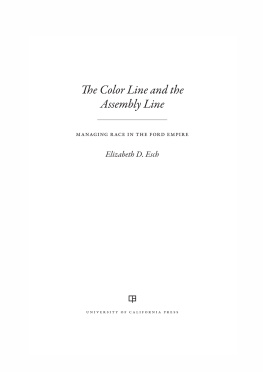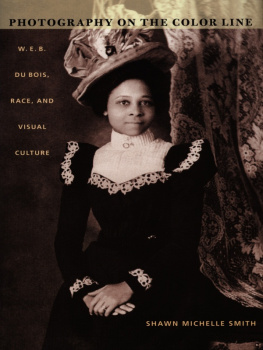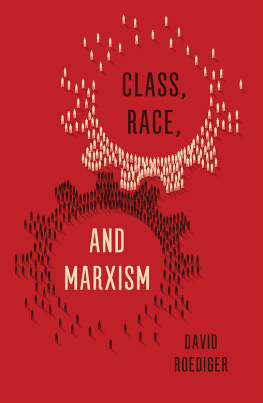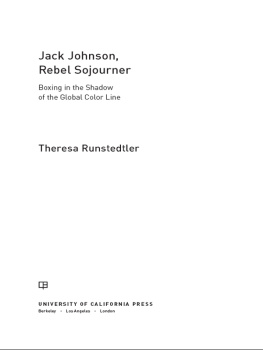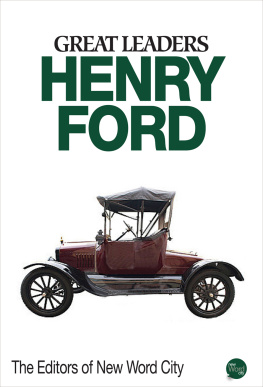Edited by Earl Lewis, George Lipsitz, George Snchez, Dana Takagi, Laura Briggs, and Nikhil Pal Singh
For a full list of titles in the series, see the final pages of this volume.
The Color Line and the Assembly Line
MANAGING RACE IN THE FORD EMPIRE
Elizabeth D. Esch

UNIVERSITY OF CALIFORNIA PRESS
University of California Press, one of the most distinguished university presses in the United States, enriches lives around the world by advancing scholarship in the humanities, social sciences, and natural sciences. Its activities are supported by the UC Press Foundation and by philanthropic contributions from individuals and institutions. For more information, visit www.ucpress.edu.
University of California Press
Oakland, California
2018 by The Regents of the University of California
Library of Congress Cataloging-in-Publication Data
Names: Esch, Elizabeth D., author.
Title: The color line and the assembly line : managing race in the Ford empire / Elizabeth D. Esch.
Description: Oakland, California : University of California Press, [2018] | Series: American crossroads | Includes bibliographical references and index. |
Identifiers: LCCN 2017039784 (print) | LCCN 2017043314 (ebook) | ISBN 9780520960886 (e-edition) | ISBN 9780520285378 (cloth : alk. paper) | ISBN 9780520285385 (pbk : alk. paper)
Subjects: LCSH : Ford Motor Company. | Racism in the workplaceMichigan20th century. | Racism in the workplaceBrazil20th century. | Racism in the workplaceSouth AfricaPort Elizabeth20th century. | Automobile industry and tradeEmployeesSocial conditions20th century.
Classification: LCC HD 9710. U 54 (ebook) | LCC HD 9710. U 54 F 27 2018 (print) | DDC 331.6/3dc23
LC record available at http://lccn.loc.gov/2017039784
27 26 25 24 23 22 21 20 19 18
10 9 8 7 6 5 4 3 2 1
To my parents, Raymond Gates Esch, Junior, and Janet Allen Esch
And to the millions of Ford workers across the world yesterday, today, and tomorrow
CONTENTS
ILLUSTRATIONS
PREFACE AND ACKNOWLEDGMENTS
Many years ago I became intrigued by the detail from Diego Riveras Detroit Industry frescoes that appears on the cover of this book. Why, in the midst of an epic work celebrating human labor on one hand and technological innovation on the other had Rivera decided to insert the scowling figure of Ford production manager Charles Sorensen in such a literal way? Other named figures in the frescoesarts patron Edsel Ford, Detroit Art Institute director William Valentiner, inventor Thomas Edisonappear largely as symbols, tribute to one or another accomplishment and in gratitude for offering this commission to Rivera. But Sorensenpopularly known among workers as the slave-driverappears here doing just what he did in reality: pressing workers through fear and the threat of force to work faster on the assembly line. Dressed in a business suit and clutching the clipboard thatlike the stopwatchsignified Fords constant surveillance of workers movements and attempts at self-expression Sorensens fierce and hovering presence is a potent representation of how power was wielded and production was achieved on Fords assembly lines.
This detail is also captivating in its depiction of who is being managed. The two workers who form a triangle with Sorensen are of different races, one with light skin and one with dark. In the Rouge that Rivera depicted these men could possibly both be European immigrant workers, one possibly Slavic, the other perhaps Italian. Representing such differences as highly visible between two people counted today in the United States as white would have been consistent with how people understood and saw racial difference marked by color and hierarchy in 1932. But we could also assume that here Rivera was intentionally situating a Black and a white worker side by side, co-managed by the same intensity, the same rules and in the same job in the plant. Not only would this be consistent with Riveras own idealism about the harmonious potential of the factory, but surely Rivera would have known also that Henry Ford was famous for his unprecedented hiring of Black workers at the Rougethis might even have been noted by the company itself as Rivera visited and studied the Rouge plant in preparation for his work.
It is nonetheless unlikely that Rivera would have actually encountered a Black worker next to a white worker on the production line in the early 1930s at the Rouge. While it is true that Ford boasted of his employment of Black workers in every department and had hired nearly 10,000 African Americans by 1930, the existing record and anecdotal evidence suggest that it is highly unlikely that a Black worker would have been employed in this aspect of production. It would be far more likely to see a Black and a white worker side-by-side in the enormous foundry at the Rouge where jobs that had been held at Fords first assembly line by Eastern European workers were more and more frequently being filled by African American workers. Even this, though, was a department becoming segregated as Eastern Europeans refused to do jobs increasingly considered Black.
That Ford hired such large numbers of African American workers led historians who studied Ford and the unionization of Detroit to accept the claim that the best way to describe Henry Ford was as a paternalist, a believer in uplift through work and wages. At a time when no other auto firms hired Black workers, surely, the thinking went, it would not be possible to view Henry Ford or his company as racist. Yet to not consider that racism may have structured Fords decision to hire Black workers is to fall into a habit that has become far too easy in telling histories of race and segregation in the United States. After all, this was not the Jim Crow South, this was Detroit, soon to be named the Arsenal of Democracy, and because life conditions for African American workers may have been better there than in, say, Birmingham, Alabama, historians tend to thus describe it as less racist. And certainly a firm that actually hired Black workers could not be as racist as those that refused to do so.
How then do we account for the subsequent history of racist segregation in work, housing, and education; the racist violence; the difference in life expectancy; and the denial of mobility that characterized the growth of Detroit and its suburbs? If the richest man in the world and one of the three most powerful employers in Detroit and in the United States as a whole was promoting non-racialism surely this should have given a different character to what used to be called race relations in Detroit. And how do we account for the fact that by 1965 Black rank and file auto workers at the Rouge plant were fighting against their segregation into production jobs they had once been excluded from? Access to job classifications had changed at the Rouge but the fact of racial segregation and differential treatment in the plant had not. Nor had deeply segregated patterns of housing or home ownership.

